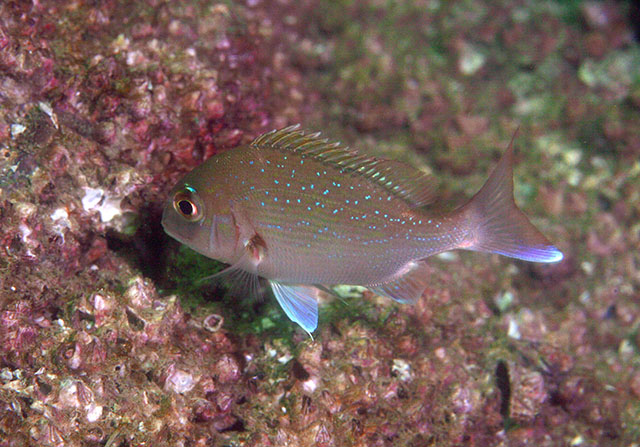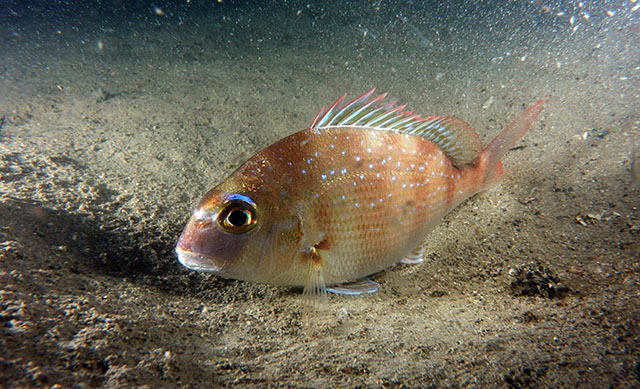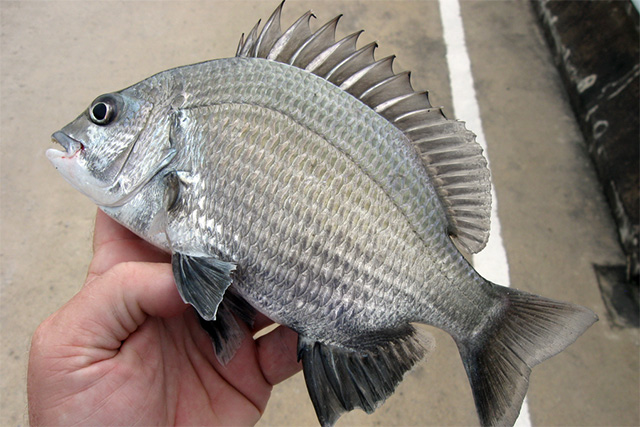Getting to Know Sparidae Fish: The Keeper of the Balance of Indonesia’s Marine Ecosystem

Red seabream (Photo Credit : Andy Cornish/Hong Kong Reef Fish Survey)
The Sparidae family, known as seabreams and porgies, includes a wide variety of fish species that are scattered in tropical and subtropical waters. The fish in this family are known for their compact and strong bodies, as well as considerable size variations, ranging from small species to large-sized fish of high economic value. They are often found in coastal waters, coral reefs, and estuarine areas, and play an important role in marine ecosystems as medium- to large-scale predators.
The family Sparidae consists of fish with compact bodies and slightly flattened laterals, which generally have a wide body shape at the top and narrow at the bottom. These fish have long dorsal fins and are separated into two parts, with the first dorsal fin having hard spines and the second fin having soft spines. The tail fins are usually branched and strong enough to allow for quick movement. The mouths of Sparidae fish tend to be strong with sharp teeth to chew on food such as invertebrates, mollusks, and crustaceans. Their body color varies, with many species having a silver or yellow color, while some others have a bright red or orange color. Fish in this family vary in size, from small to large species, with body lengths that can reach more than 1 meter in certain species. Their strong and adaptive body structure allows them to survive in a variety of coastal habitats, coral reefs, and estuarine areas.
The family Sparidae belongs to the order Perciformes, which is part of the class Actinopterygii (finger-fined fish), and the kingdom Animalia. The family includes more than 20 genera, with species widely distributed in tropical and subtropical waters. Some of the main genera in this family include Acanthopagrus, which includes species such as Acanthopagrus latus (yellowfin seabream), Pagrus which includes species such as Pagrus major (red seabream), Sparuswhich is famous for the species Sparus aurata (gilthead seabream), and Diplodus and Pagellus. Fish in this family have high ecological and economic value, play an important role in the seafood chain and are widely used as targets for commercial fisheries in various countries.
Getting to Know the Main Characters: Acanthopagrus and Pagrus
Of the many species of Sparidae, two that stand out in Indonesian waters are Acanthopagrus latus (yellowfin seabream) and Pagrus major (red seabream). Both are not only ecologically important, but also an interesting example in scientific studies.
- Acanthopagrus latus

Acanthopagrus latus (Photo Credit : Cook, D.C.)
Yellowfin seabream are known to be able to survive in environments with highly variable salinity. This makes it an ideal model for the study of osmoregulation—that is, the ability of organisms to regulate salt levels in their bodies—which is critical for the survival of fish in estuaries, lagoons, and estuarine regions. Research by Zhu et al. (2020) shows that A. latus has complex physiological mechanisms for adapting to euryhaline environments, including extreme salinity changes. Not only that, other research by Lü et al. (2022) revealed that this fish is also interesting to study in the context of sex differentiation, because it shows hermaproditic abilities under certain environmental conditions. Studies like these are important to understand how marine species adapt in the face of environmental pressures and global climate change.
- Pagrus major

Pagrus major (Photo Credit : Gomen See/Hong Kong Reef Fish Survey)
Meanwhile, the presence of Pagrus major in the eastern waters of Indonesia provides interesting information about the biogeographic distribution of the Sparidae family in the Indian Ocean. Using DNA barcoding techniques — a modern method of identifying species through small pieces of DNA — Nuryanto et al. (2023) managed to confirm the existence of this species, which was previously better known in Japan and China. These findings support the importance of a molecular approach in evaluating the richness of Indonesia's marine species, while also showing that the distribution of Sparidae fish is not as narrow as previously thought.
The Ecological Role of Sparidae in the Seafood Chain
The existence of the Sparidae cannot be separated from its role in the seafood network. From omnivorous fish to carnivores, they occupy intermediate positions in the food chain, preying on small invertebrates and sometimes other smaller fish, as well as becoming food for larger predators. Sparidae fish are an important component in the diet of apex predators such as snapper and grouper. This makes them an important 'link' between the lower and upper trophic levels in marine ecosystems. If their populations are disrupted, the effects could spread to various levels of the food chain. The importance of this trophic position is also reinforced by data from direct observation and analysis of the stomach contents of marine predators in various locations in Indonesia, which shows the high frequency of fish consumption of the Sparidae family. That is, they are an important part of the stability of coastal ecological systems.
Sparidae: Keepers of the Balance of Interdependent Coastal Ecosystems
Seagrass is an underwater ecosystem that is very important for many species of fish, including members of the Sparidaefamily. Seagrass provides a nutrient-rich habitat and shelter for small fish, which are part of the food chain for predators such as spards. Many species of Sparidae, including Acanthopagrus and Pagrus, are known to rely on seagrass beds as their spawning grounds or juvenile residences. In seagrass areas, these fish can find refuge from predators and abundant food resources, such as invertebrates and algae that grow in the vicinity. Younger or juvenile Sparidae are often found in seagrass ecosystems as areas of enlargement. These habitats provide protection from larger predators and give them the opportunity to grow and develop before migrating to more open habitats.
Diversity and Dissemination
Not only important from a functional perspective, Sparidae also contribute to Indonesia's marine biodiversity. Studies of fish larval assemblage conducted in various coastal areas show that Sparidae larvae are present in high variation, indicating the presence of healthy and diverse reproductive populations (DABAN & İşmen, 2020). This larval distribution pattern reflects local oceanographic dynamics, such as currents and tides, and suggests that Indonesia was an important place for the early development of Sparidae fish. This is also in line with the results of biodiversity research which indicates that Indonesia's tropical waters are the center of global marine species diversity. In other words, the high diversity of Sparidae is an indicator of a healthy ecosystem, as well as a very valuable genetic resource.
Conservation Challenges and Threats
Unfortunately, the existence of Sparidae in Indonesian waters also faces various pressures. Overfishing, degradation of coastal habitats such as coral reefs and seagrass beds, and marine pollution all contribute to the decline of their populations. One species of concern is Acanthopagrus pacificus, which has a high commercial value and is increasingly found in fishermen's catches. In this context, genetics-based conservation approaches are beginning to be widely developed. DNA studies can help identify vulnerable or unique local populations, which can then be prioritized in sustainable fisheries management plans.

Acanthopagrus pacificus (Photo Credit : Jean-Francois Helias/Fishing Adventures Thailand)
Conservation efforts must also involve coastal communities, as the success of species protection programs depends heavily on their awareness and participation.
Why Are Sparidae Studies Important for the Future?
Studying Sparidae is not just about getting to know one group of fish, but it opens a window into understanding how marine life works, how species adapt, and how we can maintain the balance of ecosystems that are the source of food and livelihoods for millions of people. Research on osmoregulation, genetics, and reproductive biology of Sparidae provides insights into evolution and adaptations that can be applied to other species. In addition, information about their distribution and populations is important for developing equitable and sustainable fisheries conservation and management strategies. As a country with extraordinary marine wealth, Indonesia has a great responsibility to be a pioneer in the conservation and scientific study of marine species, including Sparidae.
Protecting the Sparidae, Protecting Our Oceans
Sparidae fish may not be the main stars in Indonesia's fishing industry, but they are an important foundation of a healthy marine ecosystem. Through scientific research, data-driven conservation approaches, and community engagement, we can ensure that their existence remains sustainable — not just for current generations, but for future generations as well. Let's get to know them, learn and protect them, because keeping the Sparidae means keeping Indonesia's oceans alive.
-Yuni Sulaiman
References
Zhu, J. et al. (2020). "Adaptation to salinity variation in Acanthopagrus latus." Marine Biology Research.
Lü, X. et al. (2022). "Sex differentiation and genetic basis in yellowfin seabream." Genetics and Evolution.
Nuryanto, A. et al. (2023). "DNA barcoding reveals Pagrus major in Eastern Indonesia." Indonesian Journal of Marine Science.
Nuryanto, A. et al. (2024). "Ecological roles and threats to Sparidae in Indonesia." Marine Ecology Indonesia.
DABAN & İşmen (2020). "Larval fish assemblage and species richness." Journal of Fish Biology.
Sylla, M. et al. (2017). "Marine biodiversity monitoring and management." Coastal Ecosystem Studies.

